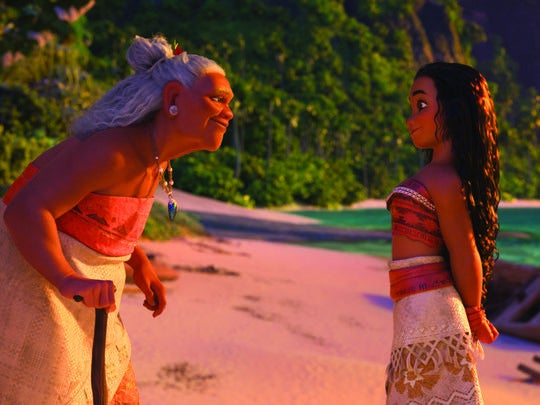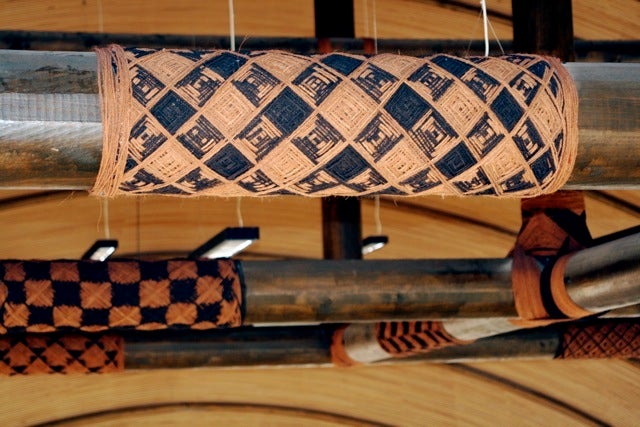
Gramma Tala and Moana.
The overhyped Disney animated film "Moana" arrived in theaters across the U.S. this week. After months of debate, I decided to watch it with my wife on the first night it opened in Hawaiʻi.
As a Tongan cultural anthropologist who has been critical of Disney’s “Moana,” I went to the theater bracing myself for the Disneyfication of my culture. Minutes in, it became obvious that despite its important girl-power message, the film had a major flaw. It lacked symmetry by its omission of a heroic goddess.
By failing to do this, Disney resorted to reducing the mighty god Māui to a one-dimensional, selfish, borderline abusive, buffoon to foreground the strength of the movie’s protagonist Moana.
The omission of a goddess-heroine is significant because Polynesia is a culture with a vast pantheon of powerful heroic goddesses. Hina, a companion goddess to the god Māui, was nowhere to be found in Disneyʼs imagineering of Moana.
Some may argue that this is a minor oversight. But to me, a descendant of Māui and Hina, this is a form of colonial erasure that amounts to failure in oceanic proportion.
Moreover, it is a clear symptom of a much deeper problem. That is, the Disneyfication of Polynesian tales produces shallow versions of deeply complex indigenous stories. This appears to be the case with Disney’s mining of Polynesian stories by extracting the god Māui and discarding his complementary deity, the goddess Hina.
It is a pernicious problem of destructive disconnection that is ever plaguing the colonial extractive industries in their mining of oil, precious metals and rocks, phosphates, cultural stories and symbols, and seabed minerals.
Let me share with you why the heroic goddess Hina is so central to the depth of Polynesian mythologies, especially stories with a powerful god of the stature and mana of Māui.
Hina is the archetypal goddess while Māui is the archetypal god. This duality of female and male deities appears in various forms in Polynesian legends as Hina and Sinilau, Hine and Tinirau, Sina and Tuna, Hina and Rū, or Hina and Kū. At times, the duality is complementary, and at other times, it is rife with tensions.
In Polynesian lores, the association of a powerful goddess with a mighty god creates symmetry which gives rise to harmony, and above all, beauty in the stories. This symmetrical configuration is a common motif.
Within the indigenous-based Tā-Vā (Time-Space) Philosophy, symmetry or rhythmicity creates harmony and beauty (Māhina 2010). This is vividly displayed in many of the Oceanian art forms, in myths, proverbs, chants, incantations, fine mats, tā tatau (tattoos), tapa cloths, performances, drummings, and lalava – the exquisite decorative-binding lashing. In Tongan lalava, the black coconut-sennit cord signifies female, and the red/brown coconut-sennit cord denotes male (Tamale; Filipe Tohi 2002; Potauaine & Māhina 2011).
The symmetrical interweaving of these two sennit cords creates kupesi, intricate-complex geometrical designs, like the patterns in Māuiʼs tattoos (see photo below). Similarly, in Polynesian myths, the symmetrical juxtaposition within the same mythological narrative of a powerful god, like Māui, and an equally mana-ful goddess, like Hina, constitutes harmony, and of course, mālie (beauty).
Hina, as the archetypal goddess, is one of the oldest matriarchal deities in Polynesia. She is the goddess that is most widely known throughout Polynesia. She is known as Hina, Sina, Hine, and Ina. Many of the Polynesian goddesses have names with the prefix Hina/Hine/Sina/Ina. Traditionally, Hina is closely linked to the moon, ocean, sea creatures (particularly sharks, corals, and spiny creatures), tapa making, mat weaving, coconut, breadfruit, and beauty. In most Māui accounts, Hina is the supreme source of Māuiʼs mana, supernatural power.
Depending on the version, the goddess Hina (or Hina-like goddess) is Māuiʼs grandmother, mother, wife, or sister. In one Māori version, Hina is the oldest sister of Māui. She taught Māui how to use her hair to plait a supernatural rope for snaring the sun and lengthening the days.
By using her hair, Hina infused Māuiʼs sun-snaring lasso with mana. In one legend, Māui attempted seven times to capture the sun and failed. He finally succeeded on the eighth try when he used a rope made from Hinaʼs hair. In Hawaiʻi, Hina is a central goddess in Māuiʼs land fishing expeditions. In one version, Māui threw his fishhook to the ocean and called upon Hina for help. Hina took Māuiʼs fishhook and carried it deep into the moana (ocean). She fastened it to the mouth of the protector one-tooth shark, Kaʻunihokahi, who was responsible for holding down the islands. In this version, it is both Hina and Maui who fished up the Hawaiian Islands. Like Māui, Hina is a land-fisher.
Here in Kahuku where I live, Hina (Waka) secured and fastened the floating island of Kahuku to Oʻahu with two mighty fishhooks (In another version, this feat was accomplished by Māui). The close relationship between Hina and sharks appears in the Tongan legends of Hina shape-shifting into a shark. Yes, Hina can shape-shift like Māui. In Tonga, shark hunters recite a chant, in chiefly language, to the shark goddess Hina for success in their shark fishing expeditions. This is why in some stories Hina resides undersea.
In another Hawaiian legend, Hina is the mother of Māui. She bestowed upon Māui the magical rope and adze to snare the sun. It was also Hina, in the form of an ʻalaeʻula, mudhen bird, who taught Māui the secret of firemaking in Hawaiʻi. Māui, in one Hawaiian account, used the ʻalaeʻula bird as bait for fishing up islands. In one Samoan tale, Māui obtained his powerful fishhook from Sina (see Jacob Fitisemanu). Several of the legends give credit to Hina or Hina-like figure (Muri-ranga-whenua in Aotearoa or Tavatava-i-manuka in Tonga) for granting Māui his fishhook. Other tales say that Māui fashioned his fishhook from a shell from Hina’s reef. Hina and Māui are also memorialized in the landscapes of the same locality. In my ancestral home island of Koloa, Vavaʻu, Hinaʼs Cave (ʻAna ʻo Hina) and ʻAtalanga (Māuiʼs residence) are located in the same island. Finally, the complementary roles of Hina and Māui are manifested in their respective links to the moon and the sun.
Mythologically, Hina is the lunar goddess while Māui is the solar god. During the day, Māui guides voyagers with the sun, and at night, Hina directs them with the moon. In Tahiti, Hawaiʻi and Tonga, Hina is seen sitting in the moon beating tapa. Like Māui, Hina is intimately connected to navigation. According to Tahitians, Hina is the guardian and protector of travelers at night. In one Hawaiian tale, the moon and the stars escaped to the heavens from Hina’s food calabash. All of these complementary roles of Hina and Māui are revealed in the foundational colors of dark and light in Polynesian geometrical designs, kupesi. Again, the symmetrical intertwining of dark/Hina and light/Māui creates beautiful intricate-complex geometrical patterns.
By excluding the goddess Hina, Disney created a simplistic and asymmetrical story. Which is why the Disney story falls flat. Disney rendered Māui as comical, selfish, and misogynistic to highlight Moanaʼs strength and significance. Moreover, it portrayed Māui a self-absorbed god.
The song “You’re Welcome” is Māui boasting about his greatest achievements without the slightest acknowledgement of Hina’s powerful role. All of these problems stem from the erasure of the mighty goddess Hina from the story.
If you are still wondering about Hina’s immense power, you may want to consult the Māori legend in which Hine-nui-te-pō crushed Māui to death for attempting to destroy her and gain immortality by entering through her birth canal.
But what about the female characters in Disney’s Moana? Are they not proxies for the goddess Hina? No. Moana’s mother, Sina, had the divine name but not the power to act as a goddess. Gramma Tala, on the other hand, somewhat resembled the goddess Hina. She aided Moana, as a human and as an ʻaumākua (ancestral deity) in a stingray, by encouraging Moana to find Māui and restore the heart of Te Fiti. Yet, she did not provide mystical power in the level of Hina.
What about the “anthropomorphic” ocean? She had some oceanic elements of Hina but not Hinaʼs full divine power. Then, there was Te Kā, the highly problematic lava monster, who was an enemy to Māui and Moana but not an ally like Hina. Lastly, there was Moana. She is the one that resembled Hina the most. She aided Māui and some might say that Maui aided her, but Moana did not wield supernatural power like Hina.
Had Disney identified Moana as a descendant of the goddess Hina, Moana would have had the genealogical and ancestral ties to Hinaʼs mana. But, Disney did not give Moana this genealogical connection. And, that is the central problem with the Disneyfication of Polynesian stories. It lacked genealogy, symmetry, and indigeneity.
Overall, the film lacked indigenous intricacy and harmony. This is to be expected when any native story is filtered through Disneyʼs imagineers. The important lesson for Oceanians is that this is our story, our cultural heritage. It does not belong to Disney. It belongs to us.
Disney lacks the cultural depth to tell our stories, but we are the protectors and tellers of our cultural heritage. Let us tell our story in our own way, with complexity, symmetry, and beauty. When we do so, the Mana Moana of our two mighty ancestors Hina and Māui lives on in all of us.
Sources:
Apuakehau, J.K. 1922. O Kahuku Aina Lewa. Nupepa Kuokoa, Honolulu (June 29, 1922).
Beckwith, Martha W. 1970. Hawaiian Mythology. Honolulu: University of Hawaiʻi Press.
Craig, D. Robert. 2004. Handbook on Polynesian Mythology. ABC-CLIO, Incorporated.
Luomala, Katharine. 1949. Maui-of-a-Thousand-Tricks: His Oceanic and European Biographers. Honolulu: Bernice P. Bishop Museum.
Māhina, ʻOkusitino. 2010. “Tā, Vā, and Moana: Temporality, Spatiality, and Indigeneity.” Pacific Studies 33(2/3).
Māhina, ʻOkusitino. 2003. “Oceanic Mythology.” Mythology: Myths, Legends, & Fantasies, edited by Janet Parker and Julie Stanton, 374-381. Australia: Global Book Publishing.
Moala, Masiu. 1994. ʻEfinanga: Ko e Ngaahi Tala mo e Anga Fakafonua ʻo Tonga. Kolomotuʻa: Lali Publication.
Potauaine, Sēmisi F. and ‘Okusitino Māhina. 2011. Kula and ‘Uli: Red and Black in Tongan Thinking and Practice. In T. Steen and N. Drescher (Eds). Tonga: Land, Sea and People. Nuku’alofa, Tonga: Vava‘u Press.
Tohi, Filipe. 2002. Filipe Tohi. Genealogy of Lines: Hohoko ē Tohitohi. Auckland: Govett-Brewster Art Galley.
Varez, Dietrich and Lilikalā Kameʻeleihiwa. 1991. Māui, The Mischief Maker. Honolulu: Bishop Museum.
Westervelt, W.D. 1910. Legends of Maui - A Demigod of Polynesia, and his Mother Hina. Honolulu: The Hawaiian Gazette Co., Ltd.

Lalava, decorative-binding lashing. Dark color signifies female/Hina and Red/Light color denotes male/Māui. The symmetrical interweaving of the two colors creates beautiful geometrical designs, kupesi.
